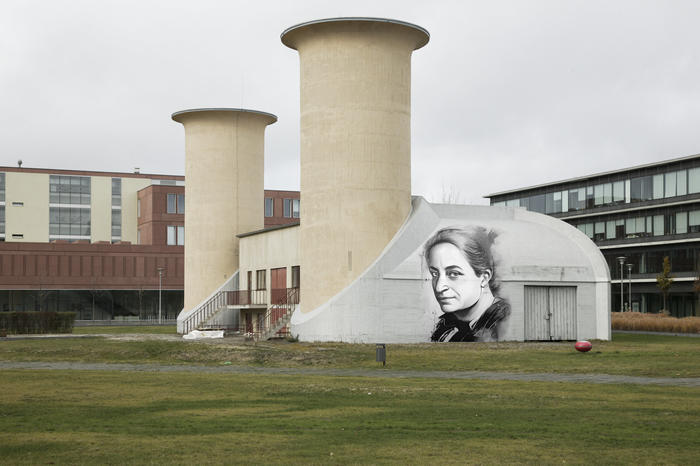Albert Einstein, Alice Salomon and Robert Koch: Back in Berlin with AI
The women’s rights activist, Alice Salomon, was born in Berlin in 1872 and is regarded as a pioneer of social work as a branch of science. In 1937, she left Germany under pressure from the Gestapo.
Image Credit: Michael Zalewski, created with Supermachine (AI)
The scene looks realistic: the picture shows a street view of Berlin, with the television tower and skyscrapers in the background and cars and a streetcar on the street. Large graffiti is emblazoned on the wall of a house: Albert Einstein poses there in a familiar pose with his tongue out. This Berlin view on Prenzlauer Allee actually exists – except for one detail: The original wall does not show Albert Einstein, but fragments of a street art work.
The work featuring the famous physicist is due to a combination of a real photograph and an AI-generated image. Einstein has become the first person to use the AI program “Supermachine” in the image created by photographer Michael Zalewski. It forms part of a series of images presenting portraits of renowned scientists such as Rudolf Virchow, Max Planck, Lise Meitner, Alice Salomon and Robert Koch in Berlin’s urban space. All of them were working in Berlin around the turn of the century; some of them spent the most important time of their careers here and shaped the Berlin research area with their outstanding work. The series of images commemorates these important personalities and places them where they once worked: in the heart of Berlin.
Prompts create the perfect picture
“It all starts with the idea,” states Michael Zalewski, explaining how such images are created. This idea behind the image is entered into the image AI in a “prompt” – i.e. a description that is as precise as possible – in text form. What motifs should the picture show? Background, time of day, even exposure time, camera model or even photography style can be specified in the prompt. From the information entered, the AI calculates an image that usually does not immediately match the expectations. With further prompts, ever more detailed information flows into the AI, which optimizes and adapts the image based on this. It can take several hours of work to get everything right. “Getting to grips with the programs and prompting is very time-consuming, especially at the beginning,” explains Michael Zalewski, describing his experiences. “If you work with it frequently, the whole process is faster.” Some image ideas can be implemented more easily, quickly and cost-effectively with AI.
Michael Zalewski required several attempts and prompts to create the perfect graffiti of Albert Einstein. “Sometimes, the nose was crooked, the facial expression funny or I didn’t like the wall of the house.” In the end, the photographer was satisfied and used an image editing program to turn the resulting graffiti into an original photograph. You can’t tell from the result that part of the image was created with the help of AI and inserted afterwards.

